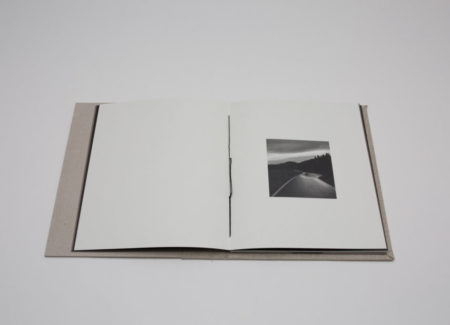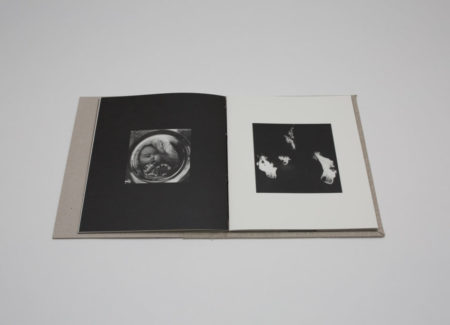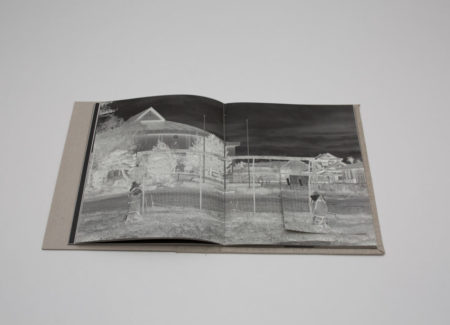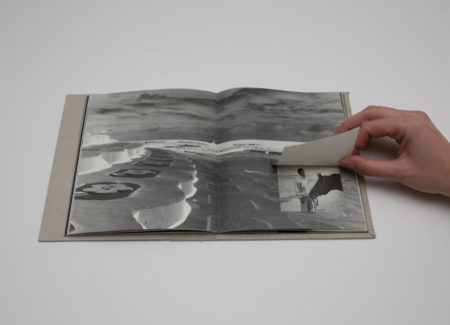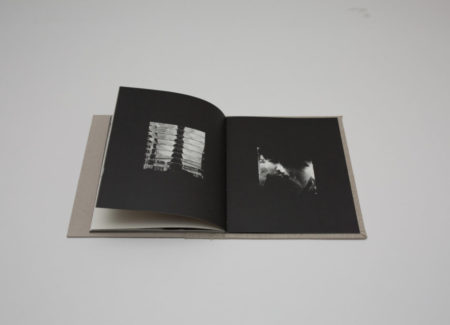JTF (just the facts): Published in 2018 by Akina Books (here). Hand-made hardcover, 80 pages, with 45 black and white photographs. There are no texts or essays. In an edition of 250 copies. Design by Valentina Abenavoli. (Cover and spread shots below.)
Comments/Context: It has been seven years since the deadly earthquake and tsunami that hit eastern Japan, triggering a devastating nuclear accident at the Fukushima Daiichi nuclear power plant. In the immediate aftermath of the event, a flock of photographers from Japan and around the world documented the physical destruction of the area. Echoing painful memories of the past, the events of 3/11 provoked a photographic response similar to the aftermath of the 1945 atomic bombings of Hiroshima and Nagasaki.
With the photobook used as creative expression but also an indicator of urgency, in the first year following the disaster, a broad range of photobooks emerged responding to both visible and unseen traces of the catastrophe. Some of the most well known titles include Mushrooms from the Forest (2011) by Takashi Homma; Light and Shadow by Rinko Kawauchi (2012); and Natural Stories (2011) by Naoya Hatakeyama. As the recovery process continues, 3/11 remains a key theme even today.
How the fears of the nuclear era intermingle with the personal experience of fatherhood is an interest of the Japanese photographer Yusuke Takagi. When the disaster happened, Takagi and his wife lived in Tokyo, yet they were very aware of the hidden dangers of radiation. Takagi decided to document the impact of the tragedy, and during the years he was working on the project, his son was born. Takagi’s photographs of the landscape of the zone and its current residents are mixed with images symbolizing his fatherhood. As a book, the project was first conceived during the “Photobook as Object Workshop” in 2016, and the next year, the dummy won the FUAM-Akina Dummy Book Award and has since been published by Akina Books.
Kagerou immediately stands out as a carefully hand-crafted object. One fourth of the cover is linen, which then continues around the spine and onto the back; a tipped-in black and white image depicts a fireball of an explosion with an added white stripe lying across it. Each copy is hand made and any imperfections are a welcome part of the process. The book’s design and sequencing (mixing Takagi’s own images with found archival elements) are intimate, and its thoughtful production choices reinforce that mood.
The title of the book is a Japanese word for “heat haze”, or in Takagi’s interpretation “decay heat powered by the nuclear radiation, invisible, pervasive”. The book opens with an archival image capturing the first milliseconds of nuclear bomb test fireball – the small black and white shot placed against black background stands in contrast to the potential devastating effect of nuclear power. It is followed by a striking photo of a pregnant woman with a shadow of a hand across her nude belly, as if protecting her and the precious cargo she is carrying. Then another image of a fireball expansion, a shot of an empty road, and another fireball. The repetitive sequence of these initial images, connecting human life and destructive power, sets the stage for book’s emotional journey, where heaviness, a sense of loss, hidden danger, and uncertainty all linger nearby.
An image of the front page of The Japan Times with the headline “Reactor fuel rods fully exposed” adds a factual reference to the narrative and a close up shot of a screaming baby on the next spread connects that reality to a very personal element of the project. The distorted image of a baby (seen in water) is then paired with what looks like spots of splashing fire. The silence and scream (also brought in through the alternating use of black and white pages) seem to intertwine in the shifting visual flow, reflecting on the range of emotions brought on by the events and their aftermath.
The landscapes of the zone – the place where the devastating impact of the disaster takes a visible shape – are full bleed spread. To reinforce the feeling of nightmare and desolation found there, Takagi has printed them in negative tones, adding a ghostly dystopian atmosphere. These landscapes feel entirely lifeless, yet under lift-back square flaps, we find portraits of the people who still live there. The spread of a soccer goal reveals a portrait of a young man posing as his teammates continue to play on the background. This design element merges the visible and the invisible, the hidden and the known, giving the images more depth of representation.
Closer to the end of the book, there is a full spread photograph of Takagi’s son: he looks through a window with his arms widely open, as the condensation on the glass surface blurs the world outside. This image symbolizes both the unseen threats of radiation and the joy of a new life, brimming with hopes and openness.
Kagerou offers a tenderly nuanced reflection of the tragic events. Through thoughtful and delicate presentation, the form of the book becomes integral to its troubling and mesmerizing narrative, creating an intimately perturbing experience. Well conceived and beautifully produced, Kagerou forces us to consider the gravity of failed human activities, the world’s fragility, and ultimately our own vulnerability.
Collector’s POV: Yusuke Takagi does not appear to have gallery representation at this time. Collectors interested in following up should likely connect directly with the artist via his website (linked in the sidebar).


